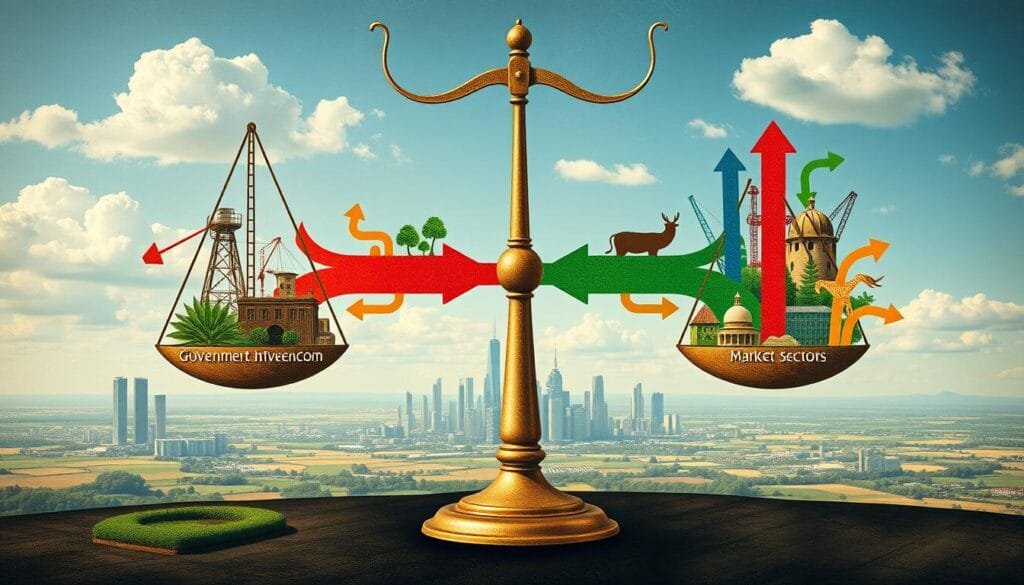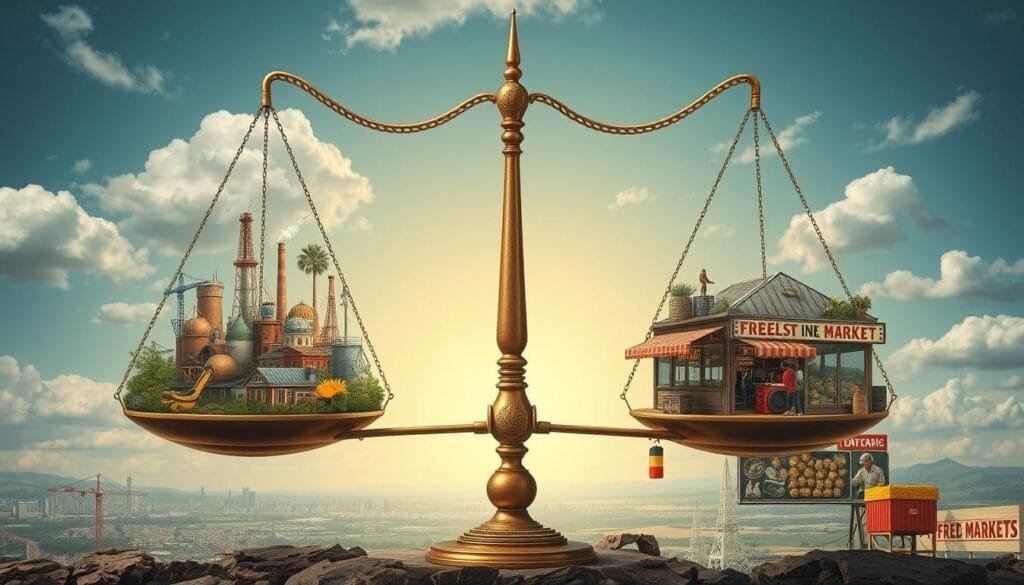Have you ever thought about how a country finds balance between private and public interests? Mixed economic systems tackle this challenge. They combine capitalism’s drive for innovation with socialism’s emphasis on equality. The goal is to make sure that the private sector’s push for profit works alongside government supervision. This is aimed at improving the welfare of society as a whole.
In these economies, like America’s, there’s a mix of capitalist and socialist methods. These methods affect how goods and services are made, shared, and used. Even though private businesses lead in many areas, the government steps in too. It does this through rules, help, and sometimes owning parts of some sectors. Essential services such as national defense and public transport often see this government role. Mixed economic systems aim for a middle ground. This ensures that people’s needs are efficiently met while also reaching important social goals.
Looking at who gains from what’s produced in a mixed economy tells us a lot. It shows how these systems strive for both economic growth and the betterment of everyone’s life. There’s a balanced aim here. It’s not just about making money, but also about providing for various needs. This includes schooling and health care.
Key Takeaways
- Mixed economic systems blend market and command economy features.
- Most modern nations adopt a mixed economic approach with varying degrees of government intervention.
- In the US, industries like agriculture and defense experience significant government involvement through subsidies and ownership.
- The aim is to balance market efficiency with social welfare, addressing broader societal needs.
- Critics argue that this balance can sometimes lead to inefficiencies and unintended consequences.
- Historical and modern examples, such as the New Deal, highlight the effectiveness and limitations of mixed economies.
- Understanding who benefits from production in a mixed economy requires examining both private and public stakeholders.
Introduction to Mixed Economies
Understanding Defining Mixed Economies means knowing they merge capitalist and socialist ideas. A mixed economy brings together private business and government control. This mix seeks to get the best of both worlds, reducing the downsides of each.
The history of economic systems tries to find a balance. For instance, Western European mixed economies have up to 20 percent of industries publicly owned. This shows how governments play a big role. Even in Ancient times and medieval societies, there were mixed economies. They were controlled by both the state and religion. This concept dates back to ancient Greek city-states and the Etruscans.
After World War II, Western Europe saw a mix of socialism and democracy. This blend was about mixing market forces with government oversight. The goal was social fairness and economic stability.
| Region | Characteristics |
|---|---|
| Western Europe | 15-20% public ownership, blend of socialism and democracy |
| Ancient civilizations | Governance via state/religion, mixed economy principles |
| Modern examples | United States, Canada, UK, France, Germany, Japan |
Countries like the United States and Germany show mixed economy traits. Each has different levels of government intervention. This affects innovation and the economy’s size. In a mixed economy, the government watches over the market. It stops monopolies and fixes market issues. But, it lets market forces control production and prices.
The goal of the capitalist-socialist balance is fairness. The government makes sure everyone can access important services like schools and hospitals. It’s hard to find the perfect balance between government control and market freedom. Economists and policymakers often debate this.
There was a big shift from old to modern liberalism toward mixed economies. Mixed economies adapt well to economic changes because they blend governance styles. Understanding mixed economies is about knowing their history and how they evolve. They aim for a balanced and strong economy.
Key Characteristics of Mixed Economies
Mixed economies mix market capitalism with government control. This creates systems that support both private ownership and economic liberty. At the same time, they ensure the public good. Countries around the world, including the United States, use a mixed economic system. This shows many ways to manage the economy.

Government plays a bigger role in these economies than in market-based ones. This often means higher taxes but also leads to important public services. Government actions like price controls or subsidies help keep vital goods accessible. They prevent monopolization and support social welfare. Mixed economies try to find the right balance. They aim for market efficiency and tackle social inequalities. They provide Help in areas like healthcare, education, and housing for everyone.
Key sectors like transportation, healthcare, and education often see partnership between private businesses and the government. For example, Australia’s government manages healthcare, while private companies run sectors like mining and finance. This teamwork shows the joint effort in ensuring economic stability and social wellness.
Factors like land, labor, and capital are managed through both government plans and market forces. Prices get influenced by these forces plus government rules. This affects areas such as utilities and healthcare. By doing this, mixed economies reduce failures in the market. They make sure everyone’s basic needs are met.
Mixed economies are good because they encourage innovation. They allow efficient producers to grow, which brings some economic stability. They also work on reducing income inequality. This is done through redistribution of wealth. It often involves taxing the wealthy more to fund public services.
Government actions in these economies include policies like tariffs and subsidies. These policies help manage resources and how the market works. They aim to solve problems like externalities and social inequalities. After the Great Recession, there was more regulation in financial markets. Central banks in various countries cut interest rates to boost the economy.
The field of economics splits into applied economics, macroeconomics, and microeconomics. Economists, who earn around $115,730 in 2023, are expected to see job growth of 6% by 2033. They work in different areas like corporate and government sectors. Their job often involves analyzing data and using statistical tools.
Mixed economies face issues like regime uncertainty, especially in democracies. Regulations change often, making the business environment unstable. Long-term economic planning becomes hard. Analysis of events like the 1929 market crash show how government interference can worsen problems. Still, mixed economies seek a balance. They aim for sustainable growth and social equity through market order and regulation.
Economic Systems Compared: Mixed Economy vs. Free Markets
When we start comparing economic systems, we see big differences. Mixed economies and free markets are not the same. These systems differ in how much the government steps in. This affects their good and bad points.

Free market economies let private people and companies make most decisions. They face little government rules. This setup leads to benefits like higher efficiency and innovation thanks to competition. Yet, it also means bigger gaps in income and unstable economic periods. Events like the 2008 crisis show these problems. Also, things everyone needs, like healthcare, might not be enough without the government’s help.
In mixed economies, the setup mixes free markets with some government control. This happens in places like the United Kingdom. The U.K. shows a good level of economic freedom. It stands at 28th in the 2023 Index of Economic Freedom. Fields like banking and business services help its economy grow.
The U.K. sees the government stepping in for public needs, making rules, and aiding in wealth distribution. It has signed three new trade deals. It also ensures consumer safety and cares for the environment. Plus, it uses policies to keep the economy stable.
Countries like North Korea are at the other end with command economies. Here, the leaders make all economic decisions. This leads to problems like not using resources well, making people poor, and not encouraging people to start their own businesses.
The following table shows the good and bad of mixed and free market systems:
| Aspect | Mixed Economy | Free Market Economy |
|---|---|---|
| Government Intervention | High (Public goods provision, market regulations) | Low (Minimal regulation, driven by supply and demand) |
| Economic Efficiency | Moderate (Balance of efficiency and welfare) | High (Driven by competition) |
| Social Welfare | Enhanced (Social safety nets, public services) | Variable (Depends on voluntary actions of private entities) |
| Income Inequality | Moderate (Redistribution measures in place) | High (Market-determined incomes) |
| Economic Stability | Higher (Government stabilization measures) | Subject to Cycles (Boom-bust patterns) |
Looking at these points gives us a better understanding. It shows how different mixed and free markets are. It highlights the impact of government rules and help on economies. These things greatly affect society.
Examples of Mixed Economies Around the World
Countries from different parts of the world use the mixed economy model. This model combines free market practices with government control. Look at examples like the United States, Western Europe, and East Asian countries.

The U.S. economic system is a great example of a mixed economy. It’s mostly driven by market forces. But, the government also has a big role through rules and public works. The government’s part of the economy is 13.3% of the GDP.
Western Europe has many classic mixed economies. They include European market regulation. For example, France’s public sector is 28% of the GDP. This shows the influence of dirigisme since World War II. Norway has a public sector that’s 32.4% of GDP. It balances welfare support with a big private sector. Norway also owns about 35% of its stock exchange’s company values.
On the other side, East Asian economies like Japan and China show different ways of mixing economies. Japan’s public sector is just 7.7% of GDP, after much privatization, such as the Japan Post in 2007. China, however, has a big public sector at 28%. It has moved a lot toward privatization since the 1980s.
To give a clearer idea, look at these numbers on public sector sizes in different countries:
| Country | Public Sector Size (% of GDP) |
|---|---|
| United States | 13.3% |
| France | 28% |
| Norway | 32.4% |
| Japan | 7.7% |
| China | 28% |
These examples show how countries differ in controlling and regulating their economies. They highlight the mix of private and public sectors in global mixed economies.
Who They Produce It For in a Mixed Economics
In a mixed economic system, both the private and public sectors benefit. This balance helps meet different needs in society. The private sector seeks profit and innovation. This drive brings economic growth and better goods for people. They keep improving and finding new ways to succeed because of competition.
The public sector wants to give everyone public goods and services, like economic welfare. This includes things we all need, such as schools, hospitals, and roads. Sometimes, the market alone can’t provide these.
- The United States mixes private sector innovation with government support. For example, it gives farmers subsidies to handle market changes.
- Scandinavian countries like Sweden and Denmark spend a lot on public services. They fund education and healthcare with high taxes.
- The Asian Tigers—South Korea, Taiwan, Singapore—focus on exports. The government invests in education, tech, and roads to help this.
Countries like the United States, Canada, and the United Kingdom show mixed economies work well. They combine private efficiency with public welfare. For example, taxes fund important services, boosting economic welfare for more people.
Mixed economies also use market-stabilizing mechanisms:
- They control prices to keep basic goods affordable in crises.
- Labor laws in places like the U.S. promote fair work and well-being.
- Environmental rules balance growth with caring for our planet.
This mix lets mixed economies stay flexible, follow market trends, and keep things stable. It helps tackle unfairness with welfare programs. Yet, we must watch for too much regulation or slow processes that can hurt competition and growth.
| Country | Private Sector Focus | Public Sector Focus |
|---|---|---|
| United States | Innovation, Efficiency | Agricultural Subsidies, Healthcare |
| Sweden | Competitive Markets | Healthcare, Education, Retirement Benefits |
| South Korea | Export-led Growth | Education, Technology, Infrastructure |
| United Kingdom | Market Efficiency | National Health Service (NHS) |
| India | Industry Innovation | Social Welfare, Labor Regulation |
Mixed economies blend private innovation with public duty well. They aim for a balance that improves economic welfare and meets needs across the board.
Advantages of a Mixed Economy
Mixed economies blend market decisions and government input effectively. They ensure resources go where they’re needed most, focusing on both growth and fairness. For example, the U.S. sees 40% of its GDP from government spending. This funds crucial services like free libraries, schools, and hospitals.
Mixed economies are big on social programs. The U.S. dedicates a large part of its budget to Social Security, aiding 65 million citizens. This focus decreases the gap between rich and poor. Typically, mixed economies have a Gini coefficient around 0.3, showing less inequality than other systems.
They also boost innovation incentives via government support. The U.S. gives about $20 billion yearly to its farmers. These funds make the market more stable and spark innovation in key economic areas.
Mixed economies bring a stable economy with laws and regulations. The U.S. has a minimum wage set at $7.25 an hour. This helps reduce the income gap. Laws also prevent companies from dominating the market entirely. The breakup of AT&T in 1982 is a prime example, affecting over 70 million users.
Investment in public infrastructure stands out in mixed economies as well. In 2020, the U.S. spent about $30 billion on federal infrastructure grants. Such investments upgrade the nation’s framework and create jobs, boosting the economy further.
| Country | Share of Government Spending as % of GDP |
|---|---|
| Iceland | 57% |
| Sweden | 52% |
| France | 52.8% |
| United Kingdom | 47.3% |
| United States | 38.9% |
| Russia | 34.1% |
| India | 27% |
| China | 20% |
| Hong Kong | 18.6% |
Mixed economies excel by balancing government control and market freedom. They allocate resources well, ensuring social programs are strong and innovation thrives. This approach boosts the economy while improving living standards and economic stability.
Challenges and Criticisms of Mixed Economies
Mixed economies aim to mix economic freedom with social welfare. But they face big problems. One main criticism of mixed economy is their regulatory inefficiencies. These can cause too much control, slowing down innovation and growth.
It’s tough to find the right balance between market freedom and government control. Get it wrong, and problems arise. Too much government can lead to high prices, while not enough control can cause issues too. For example, trying to lower unemployment might just boost inflation.
Sometimes, rules meant to make things fair can have unintended effects. Too much job security might make workers less motivated. And too many taxes or subsidies can harm how competitive the market is. These problems are common in mixed economies.
Politics often mess with economic choices, making mixed economies complex. Some say capitalism’s issues don’t get fixed in a mixed economy. They also argue that rich people owning a lot can stop true social fairness from happening.
With global economies linking together, mixed economies face even more hurdles. The need for rules to prevent monopolies is clear. Yet, finding the right amount of government control is very challenging. This mix can create problems that other types of economies don’t have.
Mixed economies have their benefits and unique challenges. They offer a middle ground between capitalism and socialism. Yet, the debate about how well they work continues to grow.
Conclusion
The idea of mixed economies is intriguing. It shows how countries balance free-market and socialist ideas. This balance leads to a smooth-running economy. Over time, many nations have used this approach for economic growth and fairness.
From the USA’s growth since the 1880s to Scandinavia’s strong welfare systems, mixed economies have been effective. They show flexibility and strength in various global scenarios.
This analysis of mixed economies points out the benefits of government intervention. In Canada and the UK, sectors like healthcare thrive under this approach. The Asian Tigers, South Korea, Taiwan, and Singapore, also excel in exports thanks to government strategies.
These examples underline the value of mixed economies. They aim for economic energy and fairness.
No single economic strategy can solve all our modern problems. Mixed economies offer a practical mix of capitalism and socialism. This approach will continue to evolve, responding to global changes.
As conditions change, so will our economic systems. A balanced approach is key for growth and fairness. By understanding and adapting, we aim for a future where economic and social goals blend smoothly.
FAQ
What is a mixed economic system?
A mixed economic system combines capitalism and socialism. It has private ownership and government intervention. This influences goods and services’ production, distribution, and consumption.
How do mixed economies balance private and public production?
In mixed economies, private companies aim for profit and innovation. Meanwhile, the public sector ensures everyone gets essential services. It helps meet society’s needs and boosts social welfare.
What are some defining characteristics of mixed economies?
Mixed economies are known for freedom in business with private ownership. They also have strong government rules. There’s a balance between market demand and government control to help society and fix market problems.
How do mixed economies differ from free markets?
Mixed economies have more government activity and rules than free markets. Government involvement leads to better social welfare in mixed economies. Free markets, however, are more efficient due to less government control.
Can you provide examples of mixed economies around the world?
Countries like the USA, Western Europe, and East Asia follow mixed economic models. They use regulatory systems, government involvement in key sectors, and social programs.
Who benefits from production in mixed economies?
Both private and public sectors gain from mixed economies. The private sector seeks profit and innovation. The public sector aims to provide essential services and welfare to meet the people’s needs.
What are the advantages of a mixed economy?
Mixed economies have smart resource use, thanks to market and government action. They invest in social welfare and create a good atmosphere for new ideas through rules and incentives.
What are the challenges and criticisms of mixed economies?
Mixed economies might struggle with too much regulation causing inefficiency. Finding the right balance between market freedom and government control can be hard. They also face political issues that can impact economic decisions.
